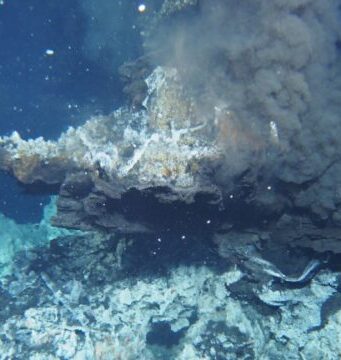A sample of green algae collected from the Gulf of Mexico. Credit: Image courtesy of The University of Alabama
The discovery of a deep-water seaweed that evolved into a multi-cellular plant more than 540 million years ago has added a...
This undated file photo shows a wolverine in Montana's Glacier National Park. Researchers are working on a plan to study wolverines in four Rocky Mountain states in the winter of 2016 to see if the animals can be reintroduced...
Mosasaur skeleton, UW Biology Building. Credit: © Alexandra MacKenzie / Flickr
Mosasaurs -- an extinct group of aquatic reptiles that thrived during the Late Cretaceous period -- possibly were "endotherms," or warm-blooded creatures, a paper co-written by a UA professor...
A fossil of Atopodenatus unicus is alongside a reconstruction showing what it would have looked like in life.Credit: © Nick Fraser
In 2014, scientists discovered a bizarre fossil--a crocodile-sized sea-dwelling reptile that lived 242 million years ago in what today...
Snapping turtle hatchling. Credit: Turk Rhen
The sex of many reptile species is set by temperature. New research reported in the journal Genetics identifies the first gene associated with temperature-dependent sex determination in any reptile. Variation at this gene in...
An illustration of a plesiosaurs on land by Henrich Harder. (Credit: Wikicommons)
A team of scientists discovered over a ton of remains, including those of plesiosaurs and mosasaurs, the Australian Broadcasting Corporation reports. The find was made on James Ross...
How did birds get their wings? Bacteria may provide a clue, say scientists.
The evolution of major novel traits -- characteristics such as wings, flowers, horns or limbs -- has long been known to play a key role in allowing...
Half of the world's fruit and vegetable crops are lost during the food supply chain, due mostly to premature deterioration of these perishable foods, according to the Food and Agriculture Organization (FAO) of the United Nations.
Tufts University biomedical engineers...
Nowhere today is the biodiversity of corals and reef-inhabiting fish higher than in the tropical waters around Indonesia and its neighbouring countries in Southeast Asia. "To understand the reason for this diversity, you have to look back 100 million...
Komodo dragon (Credit: © jjjj56cp / Flickr)
Scientists from Oxford University and Tel Aviv University have ranked the world's most 'popular' reptiles, revealing the species that capture the public's imagination and providing valuable quantitative data towards the debate surrounding conservation...
The oldest surviving species of vertebrates, such as the cane toad and the California sea lion, which have endured past extreme environmental events, will be more likely to adapt to future climate changes than younger species, such as the...


















